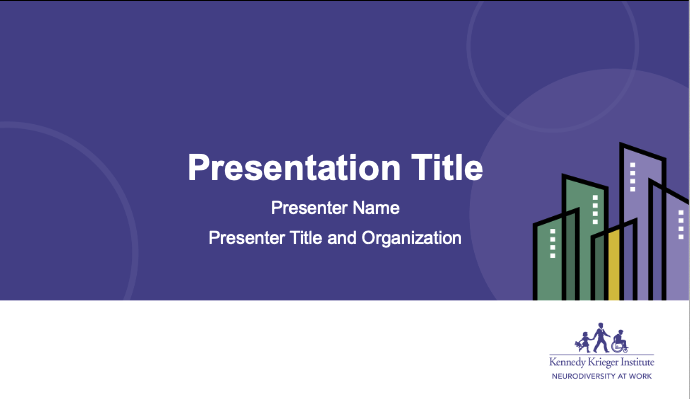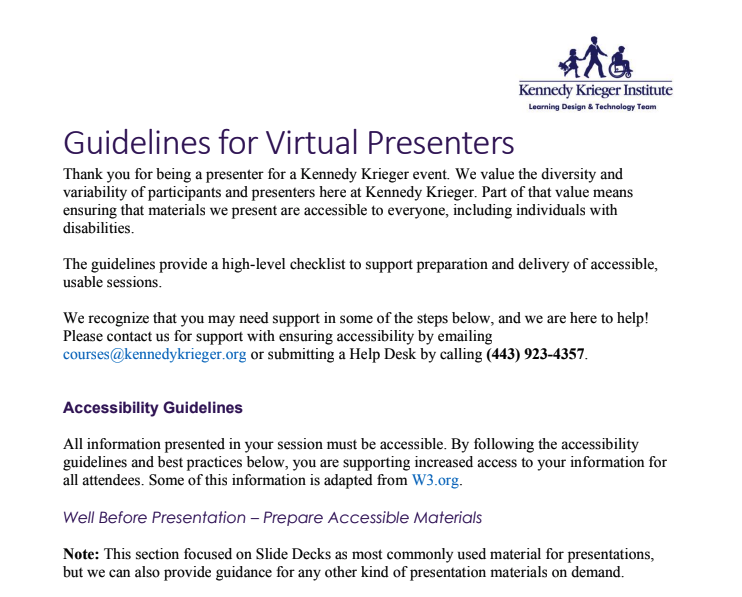Presenter GuidelinesThe below guidelines are provided to aid you in the creation and on-site presentation of your content to ensure it is accessible by all attendees before, during, and after the conference.
Why is presentation accessibility important? Attendees come from all different backgrounds and have a variety of different abilities, some of which are obvious and some which are not. Presentations with lots of visuals, small text, or complex charts may not be able to be understood by an attendee who is blind or has low vision or is color blind. Presentations that use a lot of acronyms or are packed with information may not be able to be understood by someone with a limited understanding of English or who needs a slower pace. Presentations that use uncaptioned videos may not be able to be understood by someone who is deaf or hard of hearing. A little planning can ensure all attendees are able to understand and access the content of your presentation.
|
General - Define your purpose - why are you making this presentation?
- Define your objectives - what are three key points you want the audience to take away?
- Know your audience - At what literacy level do they best communicate? How much content knowledge do they have about your topic?
- Structure your content - outline your presentation.
- Be clear in your delivery and summarize major points at the end. Time your presentation to include 10-15 minutes for discussion/questions.
|
Accessibility & Inclusion Tips Presentation slides and handouts: - Create slides in 16:9 ratio for best appearance on screen.
- Use a large, plain font and contrasting colors for readability
- Don’t overcrowd the space with too many words, pictures, etc.
- Include text descriptions of pictures and captions for videos
- Use plain language - common words and phrases, avoid jargon, explain acronyms
- Offer items in alternate formats (i.e. electronic copies, braille, large print, etc)
Cultural Considerations - Use identity- or person-first language as appropriate. For example, instead of saying "Down syndrome person," say, "person with Down syndrome."
- Include culturally and linguistically appropriate language and images that display a variety of cultural backgrounds
- When fielding questions from the audience, don't assume gender. Indicate the questioner with a neutral descriptor such as, "Yes, the person in the purple sweater."
- If sign language interpreters are present, ensure they have a copy of your presentation before you begin.
Delivery tips - Briefly describe slides and graphics as you present. For example: "This slide covers these three key points..." "This graph illustrates these key points."
- Avoid referring to items with words like "this, that, these, and those," unless you indicate what "this" means. For example: "This map shows..., These results indicate..." rather than "This shows..."
- Speak directly into the microphone. Try to avoid unnecessary movement, which can make it hard for the microphone to capture your entire speech
- Speak clearly, and at a moderate pace. This aids understanding in the audience and allows sign language interpreters or CART transcribers time to translate what you are saying
- If a presentation includes a video, be sure it is captioned
|
Additional presentation creation guidelines Text Content - Title fonts should be 44 pt. or greater. Text fonts should be 36 pt. or greater
- Don't try to cram too many slides into your presentation.
- Allow your audience time to read slides. Place no more than 6 lines of text on a slide (excluding columns).
- Include alt text graphics descriptions to aid those using screen readers and other text-based devices.
Graphic content - When graphics are used, include a detailed explanation of the meaning of the chart or graphic in a descriptive text-only slide included immediately after the graphic slide.
- Note that the meaning of the graphic is needed, not a description. For example: "Data from this chart illustrates that people with disabilities report spending more time in the emergency room than people without disabilities."
- Avoid:
- Slide transitions
- Busy slide backgrounds
- Chart fill patterns
- Over-crowding text
- Color schemes providing low contrast
- Charts without text descriptions
- Videos that are not captioned
|
Guidelines for formatting alternate materials Large Print - Large print should be printed on single-sided 8.5" by 11" paper and stapled at the top left corner
- Use letter orientation, unless a visual element requires landscape orientation, to achieve maximum visibility Left justify all paragraphs and do not use columns
- Keep a one-inch margin on all sides
- Use 18-point font for all text, including body text, footers, page numbers, references, disclaimers, and labels on charts and graphs. Larger fonts may be used for headings. Individual users may request fonts larger than 18-point as an accommodation
- Use a bold serif font (such as Times New Roman) for body text and a bold simple sans-serif font (such as Arial) for headings and other information that is set apart from body text. Do not use compressed fonts. Make lines heavy/thick in charts and graphs
- Use a minimum of 1.5 line spacing; use double spacing when possible
- Do not use small caps, italics, or all caps for text. Use initial caps and lower case for titles and text
- Use underlining for emphasis instead of italics
- Delete decorative graphics that do not contribute to the meaning of the information being presented
Flash Drive/Download - Meeting participants who are blind or have low vision may prefer to copy text files of your presentations and have their screen readers or other computer software convert the materials
- Save computer files in Rich Text or ASCII: "Rich Text Format" (RTF), a standard formalized by Microsoft Corporation for specifying formatting of documents.
Braille - The National Library Service Resource Directories list sources of Brailled materials. For more information, visit the Library of Congress' website.
|


